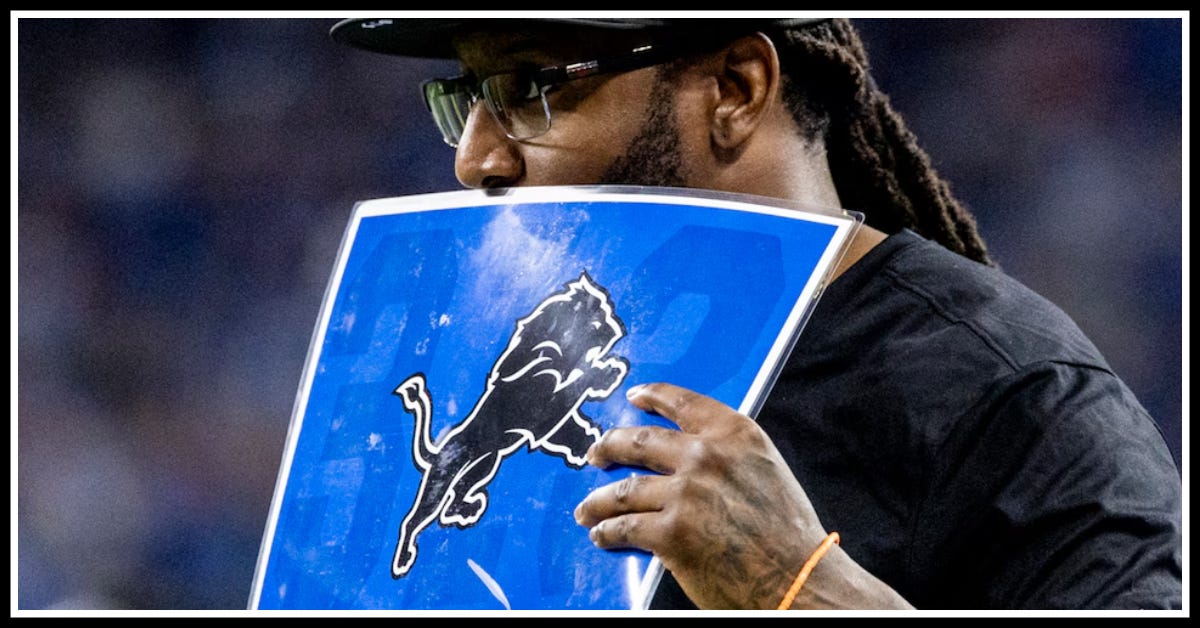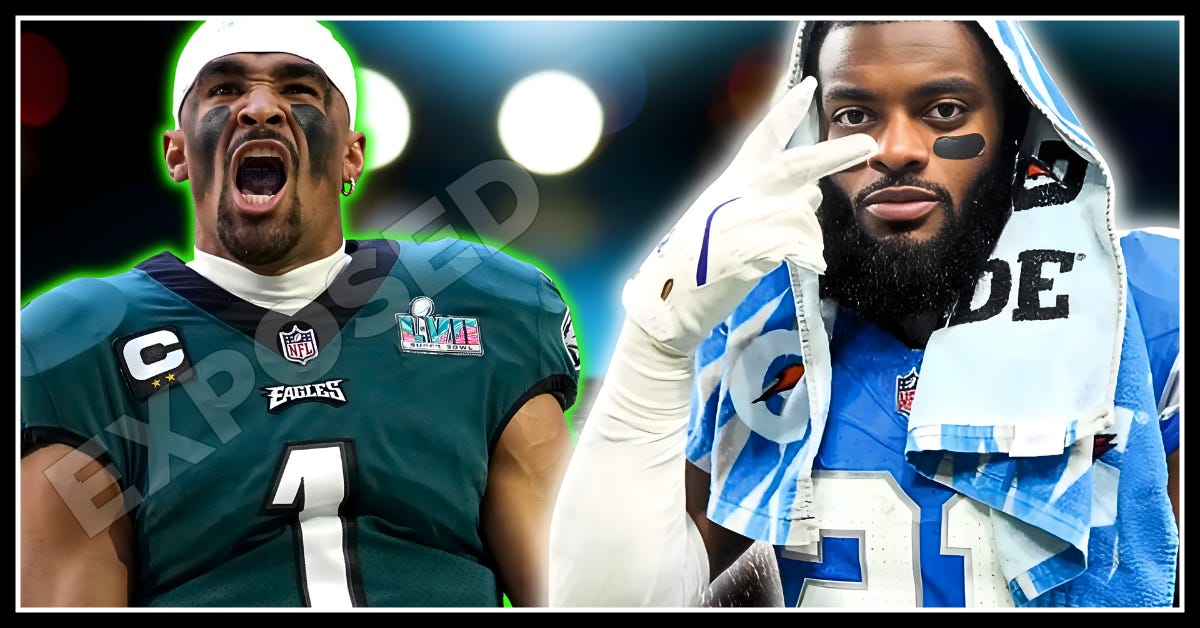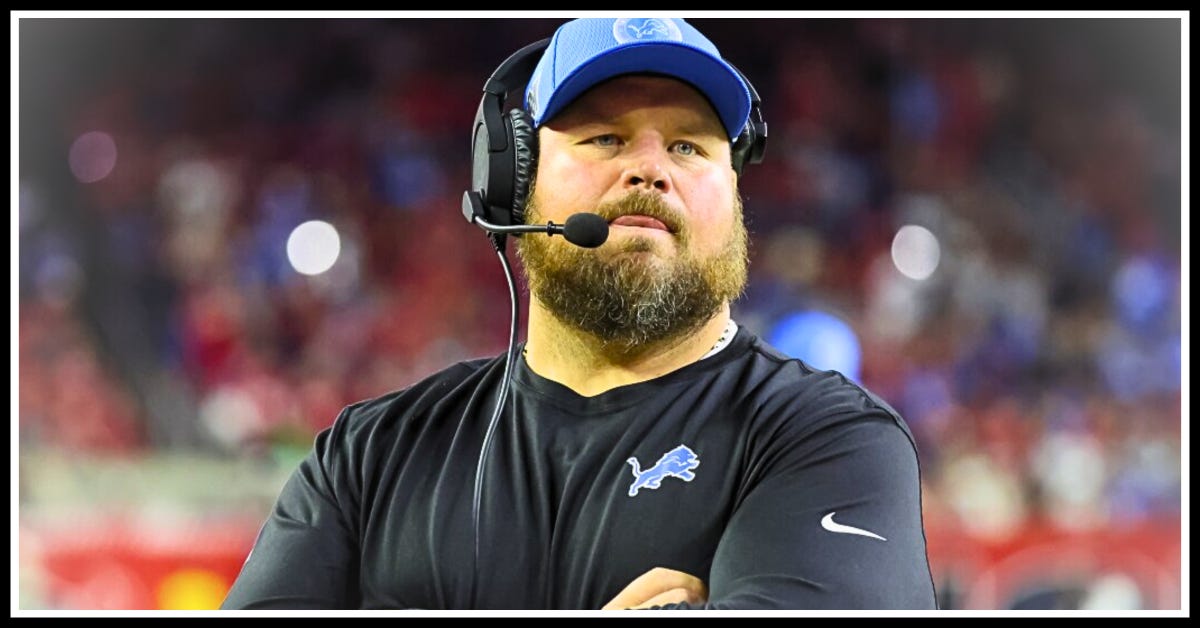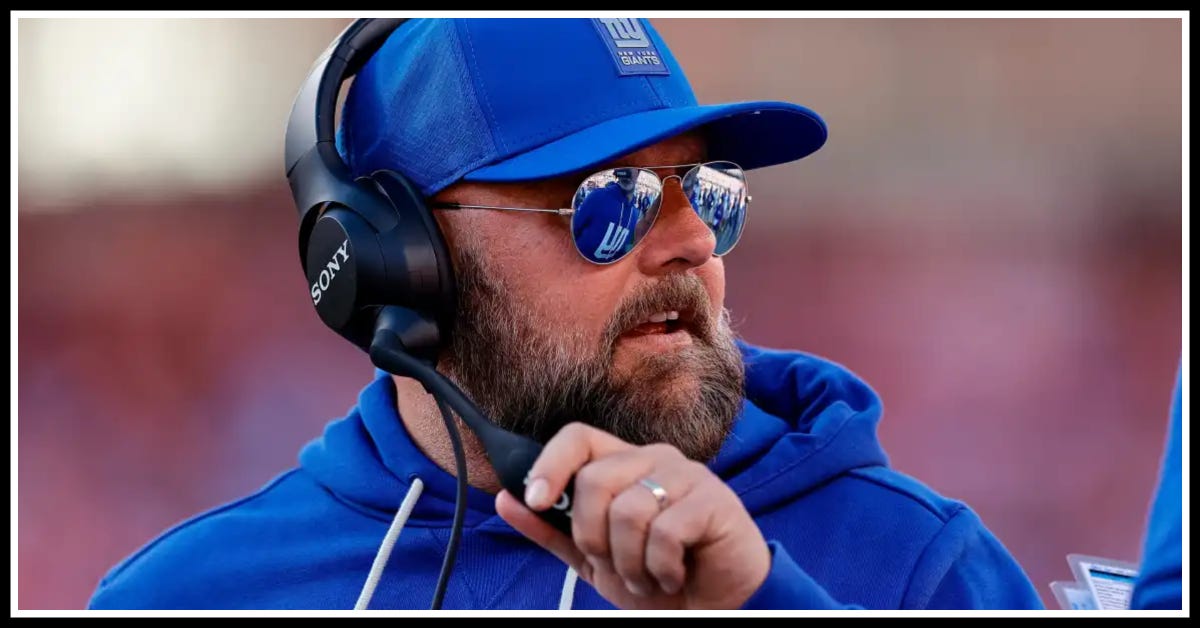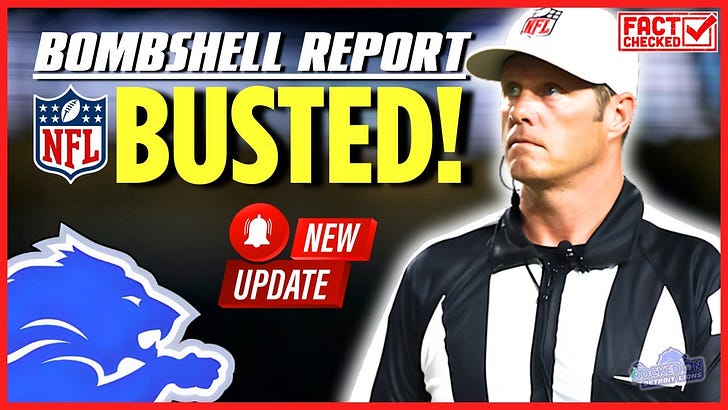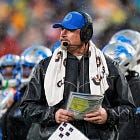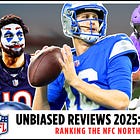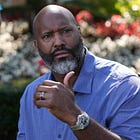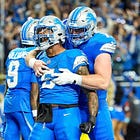How The Detroit Lions Neutralize Jalen Hurts, Saquon Barkley, Smith & Brown?
Cover 3 Hybrid with Pattern-Match from a 4-3 Under Front is the ultimate defensive system for containing mobile quarterbacks, stopping the run, and preventing explosive plays.
As the Detroit Lions prepare for their Sunday Night Football showdown against the Philadelphia Eagles at Lincoln Financial Field, defensive coordinator Kelvin Sheppard faces a monumental challenge: how do you stop one of the NFL’s most dynamic offenses featuring dual-threat quarterback Jalen Hurts and explosive running back Saquon Barkley?
The answer lies in a sophisticated defensive scheme that’s been used successfully by elite defenses for decades—the Cover 3 Hybrid with Pattern-Match principles in a 4-3 Under Front.
This Weeks Breakdowns & Analysis
Eagles Exposed - What The Detroit Lions Learned From MNF | 1 of 3
Offensive Keys To The Game | Detroit Lions Analysis | 2 of 3
Offensive & Defensive Keys To The Game | Philadelphia Eagles Analysis | 3 of 3
BONUS: How The Detroit Lions Neutralize Jalen Hurts, Saquon Barkley, Smith & Brown?
NFL Week 11: Eagles Exposed - What The Detroit Lions Learned From MNF
What’s up, Lions Nation! Will Rock here with Rocked On Detroit Lions and Detroit Football Journal. Bringing you the most comprehensive breakdown of the Lions vs. Eagles matchup you’ll find anywhere. This weeks keys to the game submission will be three separate pieces with a bonus feature.
What Is Cover 3 Hybrid Pattern-Match in a 4-3 Under Front
Condensed Breakdown: Spy QB, Stop Run, Limit Explosives
By Will Rock | Detroit Football Journal
The Detroit Lions don’t need to reinvent the wheel to beat the Philadelphia Eagles. They just need to weaponize discipline, disguise, and leverage. That’s exactly what a 4-3 Under front paired with a Cover 3 hybrid pattern-match coverage can deliver—especially when tailored to Detroit’s current defensive personnel. This isn’t just a scheme. It’s a blueprint for neutralizing Philly’s biggest threats: Jalen Hurts’ legs, Saquon Barkley’s vision, and the vertical explosiveness of A.J. Brown and DeVonta Smith.
Think of this defensive scheme as a chess match where the Lions have a specific counter for every move the Eagles make. For clarity, this breakdown assumes the Lions are at full health, which helps fans visualize ideal execution.
The Front: 4-3 Under with Edge Integrity and Interior Disruption
Start with the foundation: four down linemen and three linebackers. The 4-3 Under shifts the defensive line toward the strong side (tight end side), giving the Lions a numbers advantage at the point of attack. Aidan Hutchinson and Marcus Davenport (Hutchinson and Al-Quadin Muhammad this week) set hard edges at 5-technique, forcing outside runs back into the teeth of the defense. Alim McNeill, the 3-tech penetrator, shoots the B-gap to disrupt timing and collapse the pocket. DJ Reader, the 1-tech anchor, eats double teams and locks down the A-gaps.
Behind them, Derrick Barnes plays the SAM role—stacked or walked up depending on formation—ready to force outside runs and cover tight ends in match coverage. Alex Anzalone, the WILL, flows sideline to sideline, scraping over the top and carrying crossers in coverage. And then there’s the key: Jack Campbell, the MIKE, operating as a full-time spy on Jalen Hurts.
The Spy: Jack vs. Jalen
Campbell’s role is simple but critical: erase Hurts’ legs. He doesn’t blitz. He doesn’t drop into coverage. He mirrors Hurts from snap to whistle, maintaining inside-out leverage and closing space the moment Hurts breaks contain. His eyes stay locked on Hurts, reading his hips, shoulders, and escape angles. If Hurts rolls out, Campbell flows with him. If Hurts climbs the pocket, Campbell closes the gap. If Hurts hesitates, Campbell triggers.
This forces Hurts to stay in the pocket and beat Detroit with his arm—something he’s capable of, but far less dangerous when stripped of his off-script superpowers. It also disrupts Philly’s RPO rhythm, as Hurts can’t freely extend plays or bait defenders with run-pass hesitation.
The Shell: Pattern-Match Chaos
This isn’t pure zone coverage—where defenders drop to static areas—and it’s not pure man coverage—where defenders follow specific receivers no matter what. It’s a hybrid trap. On the back end, the Lions disguise their intentions with a Cover 3 shell that morphs into pattern-match coverage after the snap. Pre-snap, it looks like soft zone. Post-snap, it plays like man. That’s the trap.
Terrion Arnold and DJ Reed (Amik Robertson and Rock Ya-Sin this week) play deep outside thirds, using press-bail technique to funnel vertical routes inside toward safety help. They align with outside leverage, forcing receivers to release inside where Kerby Joseph (or Thomas Harper/Avonte Maddox this week) roams the deep middle. Joseph reads Hurts’ eyes, anticipates route combinations, and looks to bait throws into tight windows.
Underneath, Brian Branch and Amik Robertson (Branch and Arthur Maulet this week) handle the flats and seams. They pattern-match slot releases—meaning they’ll carry verticals, jump outs, or pass off shallow crosses depending on the route concept. Alex Anzalone and Derrick Barnes drop into hook zones but play with man-match rules: if a receiver enters their zone and continues vertically or across the field, they carry him. If the route breaks off, they pass it and reset their eyes to the quarterback.
This hybrid approach confuses quarterbacks who expect static zone spacing. Hurts sees zone pre-snap and thinks he knows where the soft spots are. But post-snap, defenders are matching routes and closing windows. That’s how you generate turnovers—by forcing hesitation, disrupting timing, and capitalizing on late throws.
The “Hybrid Pattern-Match” Part (The Secret Sauce)
Pattern-match coverage means defenders start in zone alignment, but once the routes declare, they switch to man principles. If a receiver runs vertically through their zone, they “carry” him like it’s man coverage. If the route breaks off or another receiver enters their space, they pass it off and adjust.
Why is this so effective? Because it scrambles the quarterback’s post-snap picture. Jalen Hurts sees zone before the snap and expects certain windows to be open. But after the snap, defenders are sticking to receivers, jumping routes, and closing those windows. That “open” slant or dig he thought he had? It’s suddenly covered. That’s how you force incompletions, sacks, and interceptions.
Gap Integrity and Leverage
Saquon Barkley is one of the most dangerous running backs in football because he’s patient, has elite vision, and can turn hesitation into explosion. So how do you stop him?
Gap integrity. Every defender is assigned a specific “gap”—the space between offensive linemen—and their job is to control it. If every Lion fills their gap with discipline and leverage, Barkley has nowhere to go. No cutbacks. No bounce-outs. No second-level access.
Up front, the defensive linemen control the line of scrimmage:
DJ Reader two-gaps the center, anchoring the A-gaps and absorbing double teams.
Alim McNeill penetrates the B-gap, disrupting timing and forcing Barkley to make early decisions.
Aidan Hutchinson and Marcus Davenport (or Al-Quadin Muhammad this week) set hard edges at 5-technique, keeping outside leverage and funneling runs back inside.
Behind them, the linebackers fill fast and downhill. Jack Campbell spies Hurts but still fits the run if Hurts hands it off. Alex Anzalone and Derrick Barnes scrape laterally, reading flow and plugging gaps with speed and violence. If Barkley breaks through the first wave, Brian Branch triggers from the box, filling downhill with force and finishing the play.
The key is cohesion. No freelancing. No hero ball. Just disciplined, gap-sound football. If every defender does their job, Barkley gets 3-4 yards per carry instead of 7-8. And if he’s only getting 3-4, the Eagles’ offense loses its rhythm and is forced into long-yardage situations.
The result: no cutback lanes, no explosive runs, and no second-level for Barkley to exploit. Just controlled chaos and forced frustration.
Why This Works Against Philly
The Eagles thrive on chaos—scrambles, broken plays, and explosive shots. This scheme denies all of it.
Hurts can’t scramble—Campbell is in his hip pocket.
Barkley can’t bounce—edges are set, gaps are filled.
Brown and Smith can’t go deep—three-deep coverage keeps everything in front.
Hurts can’t trust his reads—pattern-match coverage flips the script post-snap.
THE BOTTOM LINE FOR LIONS FANS
THIS IS HOW THIS SCHEME NEUTRALIZES THE EAGLES
This isn’t about exotic blitzes or gimmicks. It’s about structure, leverage, and post-snap deception. The Lions have the personnel and the blueprint. If they execute this Cover 3 Hybrid Match from a 4-3 Under front with discipline and violence, they won’t just slow down the Eagles—they’ll control the game.
Containing Jalen Hurts’ Mobility
The Problem: Hurts is a dual-threat quarterback who can beat you with his legs. He’s rushed 58 times this season and is lethal on designed runs, zone reads, and scrambles.
The Solution: Jack Campbell operates as a dedicated spy. He shadows Hurts on every snap, maintaining inside-out leverage and reacting to any movement outside the pocket. If Hurts rolls out, Campbell flows with him. If Hurts climbs the pocket, Campbell closes the space. If Hurts hesitates, Campbell triggers.
The Result: Hurts can’t extend plays with his legs. He’s forced to throw from the pocket, where the Lions’ coverage shell compresses windows and limits options.
Stopping Saquon Barkley’s Explosive Runs
The Problem: Barkley leads the NFL with 1,067 rushing yards and averages 7.4 yards per carry. He’s patient, has elite vision, and thrives on cutbacks and bounce-outs.
The Solution: Gap integrity. DJ Reader anchors the middle with two-gap control. Alim McNeill penetrates the B-gap to disrupt timing. Hutchinson and Davenport (or Muhammad) set hard edges. Linebackers fill downhill with speed and discipline. Branch triggers from the box when needed.
The Result: Barkley is limited to 3-4 yards per carry. No cutback lanes. No explosive runs. The Eagles are forced into second-and-long and third-and-long situations.
Limiting Explosive Plays to A.J. Brown and DeVonta Smith
The Problem: Brown and Smith are elite vertical threats. One deep shot can flip the game.
The Solution: Three-deep coverage. Kerby Joseph plays centerfield, reading Hurts and erasing deep seams. Terrion Arnold and DJ Reed (or Robertson and Ya-Sin) play deep outside thirds with press-bail technique, funneling routes inside and staying on top.
The Result: No vertical explosives. Everything stays in front. The Eagles are forced to string together long drives, increasing the odds of mistakes.
Creating Turnovers with Pattern-Match
The Problem: The Eagles’ offense is efficient and rarely turns the ball over.
The Solution: Pattern-match coverage scrambles Hurts’ post-snap reads. It looks like zone before the snap, but defenders match routes like man coverage once the play begins. Branch jumps option routes. Joseph baits throws. Linebackers carry crossers and close windows.
The Result: Turnovers. Kerby Joseph’s ball-hawking ability creates interceptions. Brian Branch’s physicality creates fumbles. The Lions win the turnover battle.
For tonight’s matchup: The Lions will be without their ball hawking safety, Kerby Joseph. However, the philosophy applies and the team will find ways to get the ball.
HANK FRALEY: THE PERFECT INTERNAL SOLUTION FOR DETROIT LIONS' OFFENSIVE COORDINATOR
While the Detroit Lions could chase big-name offensive coordinator candidates like Brian Daboll, the perfect solution to their play-calling crisis might already be in the building. Hank Fraley—the architect of the NFL’s most dominant offensive line and a coach who turned down the Seattle Seahawks to stay in Detroit—represents the safest, most seamless path forward for a Lions team in their Super Bowl window.
4-3 UNDER FRONT DEPTH CHART
DEFENSIVE LINE (4-Man Unit)
LEFT DEFENSIVE END (5-Technique - Edge Setter):
STARTER: Aidan Hutchinson
Backup: Al-Quadin Muhammad, Josh Paschal, Tyrus Wheat
Why: Sets edge on runs, contains mobile QBs, elite pass rusher
Role: Outside leverage, force runs inside, contain QB scrambles, rush passer
RIGHT DEFENSIVE END (5-Technique - Edge Setter):
STARTER: Marcus Davenport
Backup: Al-Quadin Muhammad, Josh Paschal, Tyler Lacy
Why: Size, length, edge-setting ability, pass rush
Role: Set edge, contain outside runs, rush passer, maintain outside leverage
3-TECHNIQUE DT (Penetrator - B Gap):
STARTER: Alim McNeill
Why: Elite penetrator, disruptive force, creates negative plays
Role: Attacks B gap, collapses pocket, disrupts timing on runs
Backup: Tyleik Williams, Mekhi Wingo, Pat O’Connor
1-TECHNIQUE/NOSE (Anchor - A Gap):
STARTER: DJ Reader
Why: Elite run-stuffer, two-gap anchor, eats blocks
Role: Two-gap center, prevent interior runs, control line of scrimmage
Backup: Roy Lopez, Tyleik Williams, Quinton Jefferson
LINEBACKERS (3-Man Unit)
MIKE (MLB - Dedicated QB Spy):
STARTER: Jack Campbell
Why: Speed, instincts, sideline-to-sideline range, perfect spy candidate
Role: Dedicated QB spy—eyes on Jalen Hurts at all times, shadow movements, prevent scrambles
Backup: Zach Cunningham, Grant Stuard, Ty Summers
WILL (Weakside Linebacker - Run-and-Hit):
STARTER: Alex Anzalone
Why: Veteran instincts, sideline-to-sideline speed, excellent in pattern-match coverage
Role: Flow to ball, fill B gap, scrape on runs, carry crossers in coverage
Backup: Trevor Nowaske, Malcolm Rodriguez, Ty Summers
SAM (Strongside Linebacker - Force Defender):
STARTER: Derrick Barnes
Why: Physical, downhill thumper, excellent against the run, handles TE coverage
Role: Force defender on outside runs, fill gaps, cover TE in pattern-match
Backup: Malcolm Rodriguez, Grant Stuard
SECONDARY (Cover 3 With Pattern-Match)
FREE SAFETY (Centerfield - Deep Middle Third):
STARTER: Kerby Joseph
Why: Elite ball-hawk, range to help both sides, creates turnovers
Role: Deep middle third, range to help both sides, jump routes, create INTs
Backup: Thomas Harper, Daniel Thomas
STRONG SAFETY (Box Safety/Robber):
STARTER: Brian Branch
Why: Versatile, physical, excellent in run support, can play robber
Role: Deep third OR robber in pattern-match, fill downhill on runs, cover slot
Backup: Avonte Maddox, Erick Hallett
LEFT CORNERBACK (Deep Outside Third):
STARTER: Terrion Arnold
Why: Physical, press coverage ability, plays deep outside third
Role: Deep outside third, trail technique on vertical routes, funnel to help
Backup: Rock Ya Sin, Khalil Dorsey
RIGHT CORNERBACK (Deep Outside Third):
STARTER: DJ Reed
Why: Physical, excellent in press coverage, plays deep outside third
Role: Deep outside third, trail technique, keep everything in front
Backup: Rock Ya-Sin, Khalil Dorsey
NICKEL/SLOT CORNERBACK (Pattern-Match):
STARTER: Amik Robertson
Why: Branch’s versatility allows him to play slot; Ya-Sin is physical in slot
Role: Pattern-match slot routes, carry crossers, play flat zone
Backup: Arthur Maulet, Avonte Maddox, Nick Whiteside
POSITION-BY-POSITION ASSIGNMENTS
DEFENSIVE LINE (4-3 Under Front)
3-Technique DT (Elite Penetrator):
Aligns in B gap (outside shoulder of guard)
Assignment: Penetrate B gap, disrupt timing, collapse pocket
Why: Creates negative plays, forces RB to bounce outside
1-Technique/Nose (Elite Anchor):
Aligns over center (A gap)
Assignment: Two-gap center, eat blocks, prevent interior runs
Why: Controls line of scrimmage, prevents RB from reaching second level
5-Technique DE (Near-Elite Edge):
Aligns outside shoulder of offensive tackle
Assignment: Set edge, maintain outside leverage, contain mobile QB
Why: Forces runs back inside to DT help, prevents QB scrambles outside
SAM Edge/OLB:
Aligns outside DE, on or off line
Assignment: Force defender on outside runs, contain edge, cover TE
Why: Sets boundary, prevents perimeter runs, handles TE in pattern-match
LINEBACKERS
MIKE (Elite Spy):
Aligns 4-5 yards off ball, center of formation
Assignment: Dedicated QB spy—eyes on QB at all times, shadow his movements
Why: Prevents scrambles, forces QB to beat you from pocket, maintains leverage
WILL (Elite Run-and-Hit):
Aligns 4-5 yards off ball, weakside
Assignment: Flow to ball, fill B gap, scrape on runs, carry crossers in coverage
Why: Sideline-to-sideline speed, makes tackles, pattern-match coverage
SAM (Above-Average):
Aligns strongside, on or off line
Assignment: Force defender on runs, set edge, cover TE in pattern-match
Why: Handles edge responsibilities, physical against TEs
SECONDARY (Cover 3 with Pattern-Match)
Free Safety (Elite Centerfield):
Aligns 12-15 yards deep, middle of field
Assignment: Play deep middle third, range to help both sides, jump routes
Why: Erases mistakes, creates turnovers, prevents explosives over the top
Corners (Above-Average):
Align 7-9 yards off, outside leverage
Assignment: Play deep outside thirds, trail technique on vertical routes
Why: Keep everything in front, prevent deep balls, funnel to help
Nickel/Slot Defender (Above-Average):
Aligns over slot receiver
Assignment: Pattern-match slot routes, carry crossers, play flat zone
Why: Handles slot receivers, disrupts timing routes, creates turnovers
Join The Detroit Football Journal Daily Podcasts Below
LATEST STORIES
NFL Week 11: Eagles Exposed - What The Detroit Lions Learned From MNF
What’s up, Lions Nation! Will Rock here with Rocked On Detroit Lions and Detroit Football Journal. Bringing you the most comprehensive breakdown of the Lions vs. Eagles matchup you’ll find anywhere. This weeks keys to the game submission will be three separate pieces with a bonus feature.
HANK FRALEY: THE PERFECT INTERNAL SOLUTION FOR DETROIT LIONS' OFFENSIVE COORDINATOR
While the Detroit Lions could chase big-name offensive coordinator candidates like Brian Daboll, the perfect solution to their play-calling crisis might already be in the building. Hank Fraley—the architect of the NFL’s most dominant offensive line and a coach who turned down the Seattle Seahawks to stay in Detroit—represents the safest, most seamless path forward for a Lions team in their Super Bowl window.
Why Brian Daboll Could Be Detroit's Next Offensive Coordinator
The New York Giants just fired Brian Daboll after a catastrophic 2-8 start, and the Detroit Lions are facing their own offensive coordinator crisis with Dan Campbell stripping play-calling duties from John Morton. Could the former NFL Coach of the Year be the answer to Detroit’s offensive struggles? An in-depth analysis reveals why Daboll’s track record with Josh Allen and the Buffalo Bills makes him an intriguing—but complicated—candidate for the Lions’ OC position should it open up in 2026.


